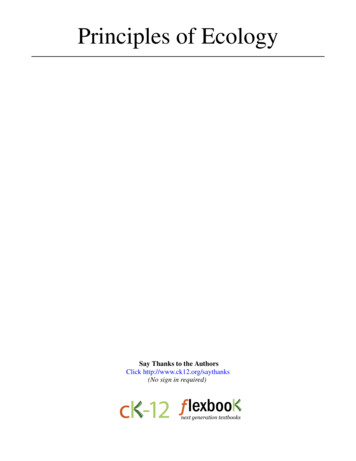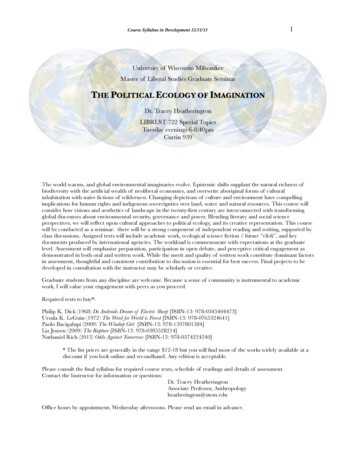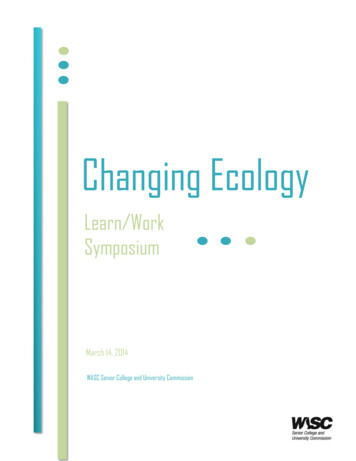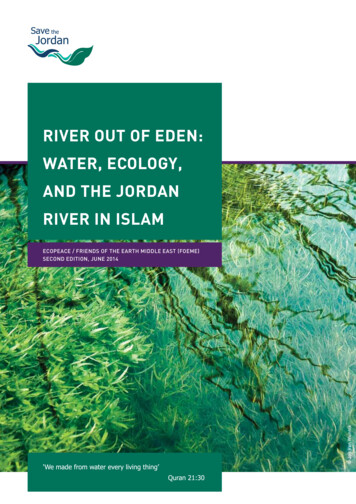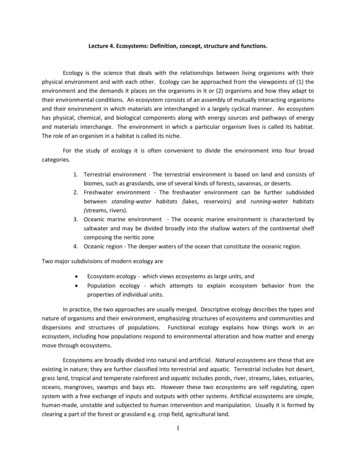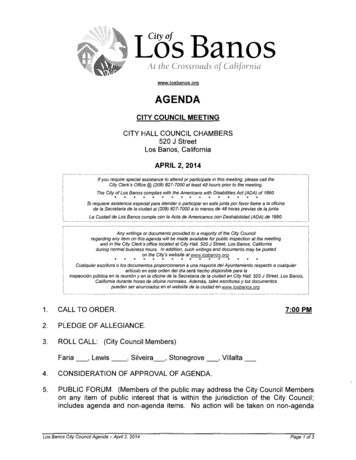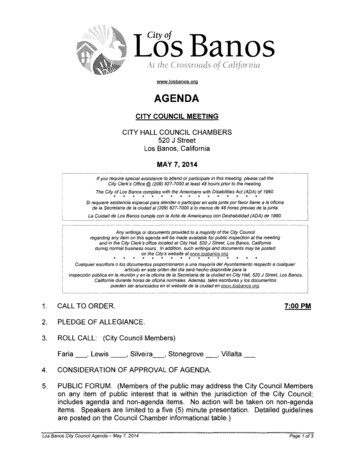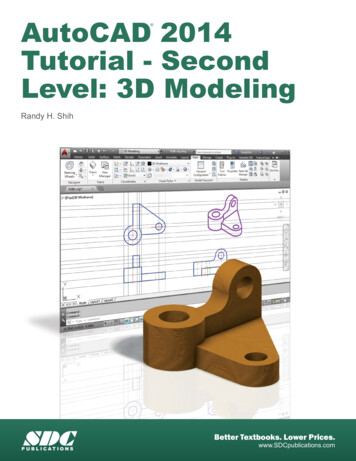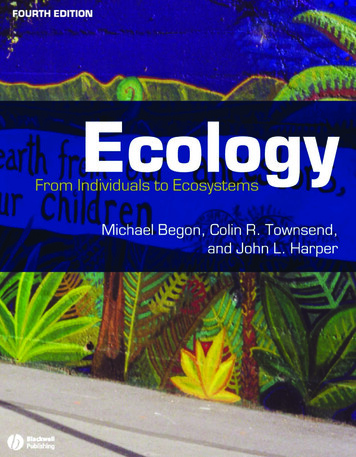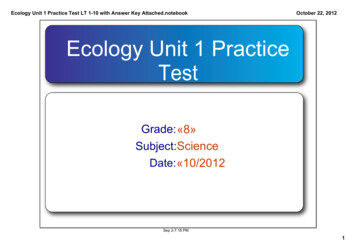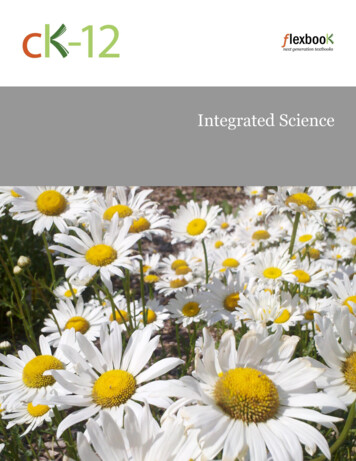
Transcription
Ecology BasicsTracy TommDana Desonie, Ph.D.Say Thanks to the AuthorsClick http://www.ck12.org/saythanks(No sign in required)
www.ck12.orgTo access a customizable version of this book, as well as otherinteractive content, visit www.ck12.orgAUTHORSTracy TommDana Desonie, Ph.D.CK-12 Foundation is a non-profit organization with a mission toreduce the cost of textbook materials for the K-12 market bothin the U.S. and worldwide. Using an open-content, web-basedcollaborative model termed the FlexBook , CK-12 intends topioneer the generation and distribution of high-quality educationalcontent that will serve both as core text as well as provide anadaptive environment for learning, powered through the FlexBookPlatform .Copyright 2014 CK-12 Foundation, www.ck12.orgThe names “CK-12” and “CK12” and associated logos and theterms “FlexBook ” and “FlexBook Platform ” (collectively“CK-12 Marks”) are trademarks and service marks of CK-12Foundation and are protected by federal, state, and internationallaws.Any form of reproduction of this book in any format or medium,in whole or in sections must include the referral attribution linkhttp://www.ck12.org/saythanks (placed in a visible location) inaddition to the following terms.Except as otherwise noted, all CK-12 Content (including CK-12Curriculum Material) is made available to Users in accordancewith the Creative Commons Attribution-Non-Commercial 3.0Unported (CC BY-NC 3.0) License (http://creativecommons.org/licenses/by-nc/3.0/), as amended and updated by Creative Commons from time to time (the “CC License”), which is incorporatedherein by this reference.Complete terms can be found at http://www.ck12.org/terms.Printed: September 22, 2014iii
Contentswww.ck12.orgContents1Introduction to Ecology2Ecosystems & Interactions2.1Food Webs . . . . .2.2Habitat and Niche .2.3Populations . . . .2.4Symbiosis . . . . .2.5References . . . . .1.4581319223Importance of Biodiversity234Conservation28iv
www.ck12.orgC ONCEPTConcept 1. Introduction to Ecology1Introduction to Ecology Define ecology. Compare field studies to laboratory studies. Distinguish between abiotic and biotic factors.Do organisms live in isolation?No, organisms are not separated from their environment or from other organisms. They interact in many ways withtheir surroundings. For example, these deer may be drinking from this stream or eating nearby plants. Ecology isthe study of these interactions. Scientists who study ecology are called ecologists.Introduction to EcologyLife Science can be studied at many different levels. You can study small things like cells. Or you can study bigthings like a group of animals. You can also study the biosphere, which is any area in which organisms live. Thestudy of the biosphere is part of ecology, the study of how living organisms interact with each other and with theirenvironment.Research in EcologyEcology involves many different fields, including geology, soil science, geography, meteorology, genetics, chemistry,and physics. You can also divide ecology into the study of different organisms, such as animal ecology, plant ecology,insect ecology, and so on.Ecologists also study biomes. A biome is a large community of plants and animals that live in the same place. Forexample, ecologists can study the biomes as diverse as the Arctic, the tropics, or the desert ( Figure 1.1). They maywant to know why different species live in different biomes. They may want to know what would make a particularbiome or ecosystem stable. Can you think of other aspects of a biome or ecosystem that ecologists could study?1
www.ck12.orgFIGURE 1.1An example of a biome, the AtacamaDesert, in Chile.Organisms and EnvironmentsAll organisms have the ability to grow and reproduce. To grow and reproduce, organisms must get materials andenergy from the environment. Plants obtain their energy from the sun through photosynthesis, whereas animalsobtain their energy from other organisms. Either way, these plants and animals, as well as the bacteria and fungi, areconstantly interacting with other species as well as the non-living parts of their ecosystem.An organism’s environment includes two types of factors:1. Abiotic factors are the parts of the environment that are not living, such as sunlight, climate, soil, water, andair.2. Biotic factors are the parts of the environment that are alive, or were alive and then died, such as plants,animals, and their remains. Biotic factors also include bacteria, fungi and protists.Ecology studies the interactions between biotic factors, such as organisms like plants and animals, and abiotic factors.Abiotic factors include the oxygen that animals breathe, the carbon dioxide plants absorb, water that organisms needto survive, and sunlight plants need to make food.Vocabulary abiotic factor: Aspect of the environment that is not a living organism, such as soil, water or air. biome: Large community of plants and animals distinguished by the dominant forms of animal and plant lifeand the climate. biotic factor: Components of the environment that are living, or were alive and then died, such as plants oranimals. biosphere: Part of the planet and atmosphere with living organisms. ecology: Study of how living organisms interact with each other and with their environment. photosynthesis: Process by which specific organisms (including all plants) use the sun’s energy to make theirown food from carbon dioxide and water; process that converts the energy of the sun, or solar energy, intocarbohydrates, a type of chemical energy.2
www.ck12.orgConcept 1. Introduction to EcologySummary Ecology is the study of how living organisms interact with each other and with their environment. Abiotic factors are the parts of the environment that have never been alive, while biotic factors are the parts ofthe environment that are alive, or were alive and then died.PracticeUse the resource below to answer the questions that follow. A Study in Stream Ecology at USGS http://gallery.usgs.gov/videos/449#.UKWeJId9KSo (6:57)MEDIAClick image to the left for use the URL below.URL: 781.2.3.4.What are some of the abiotic factors that scientists monitor when dealing with stream ecosystems?What are some of the biotic factors that scientists monitor when dealing with stream ecosystems?What is a "benchmark" in ecology? Why are they essential?How does water pollution seem to be affecting diversity in some streams?Review1. What do ecologists study?2. In a forest, what are five biotic factors present? Five abiotic factors?3. What is a biome? Give an example.References1. Courtesy of NASA. The Atacama Desert is an example of a biome. Public Domain3
www.ck12.orgC HAPTER2Ecosystems & InteractionsChapter Outline42.1F OOD W EBS2.2H ABITAT AND N ICHE2.3P OPULATIONS2.4S YMBIOSIS2.5R EFERENCES
www.ck12.orgChapter 2. Ecosystems & Interactions2.1 Food Webs Distinguish a food chain from a food web. Be able to draw and interpret a food web. Summarize the roles of producers, herbivores, and carnivores in a food web.How do the grasshopper and the grass interact?Grasshoppers don’t just hop on the grass. They also eat the grass. Other organisms also eat the grass, and someanimals even eat the grasshopper. These interactions can be visualized by drawing a food web.Food WebsEnergy must constantly flow through an ecosystem for the system to remain stable. What exactly does this mean?Essentially, it means that organisms must eat other organisms. Food chains ( Figure 2.1) show the eating patternsin an ecosystem. Food energy flows from one organism to another. Arrows are used to show the feeding relationshipbetween the animals. The arrow points from the organism being eaten to the organism that eats it. For example, anarrow from a plant to a grasshopper shows that the grasshopper eats the leaves. Energy and nutrients are movingfrom the plant to the grasshopper. Next, a bird might prey on the grasshopper, a snake may eat the bird, and then anowl might eat the snake. The food chain would be:plant grasshopper bird snake owl.A food chain cannot continue to go on and on. For example the food chain could not be:plant grasshopper spider frog lizard fox hawk.Food chains only have 4 or 5 total levels. Therefore, a chain has only 3 or 4 levels for energy transfer.5
2.1. Food Webswww.ck12.orgFIGURE 2.1This food chain includes producers andconsumers. How could you add decomposers to the food chain?In an ocean ecosystem, one possible food chain might look like this: phytoplankton krill fish shark.The producers are always at the beginning of the food chain, bringing energy into the ecosystem. Throughphotosynthesis, the producers create their own food in the form of glucose, but also create the food for the otherorganisms in the ecosystem. The herbivores come next, then the carnivores. When these consumers eat otherorganisms, they use the glucose in those organisms for energy. In this example, phytoplankton are eaten by krill,which are tiny, shrimp-like animals. The krill are eaten by fish, which are then eaten by sharks. Could decomposersbe added to a food chain?Each organism can eat and be eaten by many different types of organisms, so simple food chains are rare in nature.There are also many different species of fish and sharks. So a food chain cannot end with a shark; it must end with adistinct species of shark. A food chain does not contain the general category of "fish," it will contain specific speciesof fish. In ecosystems, there are many food chains.Since feeding relationships are so complicated, we can combine food chains together to create a more accurate flowof energy within an ecosystem. A food web ( Figure 2.2) shows the feeding relationships between many organismsin an ecosystem. If you expand our original example of a food chain, you could add deer that eat clover and foxesthat hunt chipmunks. A food web shows many more arrows, but still shows the flow of energy. A complete foodweb may show hundreds of different feeding relationships.Vocabulary carnivore: Organism that feeds on other animals. consumer: Organism that must consume other organisms to obtain food for energy.6
www.ck12.orgChapter 2. Ecosystems & InteractionsFIGURE 2.2Food web in the Arctic Ocean. decomposer: Organism that obtains nutrients and energy by breaking down dead organisms and animalwastes. food chain: Diagram that shows feeding interactions in an ecosystem through a single pathway. food web: Diagram that shows feeding interactions between many organisms in an ecosystem through multiple intersecting pathways. herbivore: Animal that eats producers to obtain energy. producer: Organism that produces food for itself and other organisms.Summary A food chain is a diagram that shows feeding interactions in an ecosystem through a single pathway. A food web is a diagram that shows feeding interactions between many organisms in an ecosystem throughmultiple intersecting pathways.PracticeWatch the video at https://www.youtube.com/watch?v 0ZOvqYypOuo to help you answer the questions on your noteworksheet.Review1. What is the difference between a food chain and a food web?2. Food chains always begin with what type of organism? Why?3. What is the herbivore in the following food chain: algae - fish - herons?7
2.2. Habitat and Nichewww.ck12.org2.2 Habitat and Niche Define habitat and niche. Describe the roles of the habitat and niche in an ecosystem.What is your niche at school?Are you on the basketball team? Are you a cheerleader? Do you play an instrument in the band? Your niche wouldbe your role or place in the school. What is your niche in your family and/or your community?Organisms also each have their own niche in the ecosystem. Is an organism a producer or a consumer? How doesthe organism interact with other organisms? Is the organism involved in any symbiotic relationships?8
www.ck12.orgChapter 2. Ecosystems & InteractionsHabitat and NicheNicheEach organism plays a particular role in its ecosystem. A niche is the role a species plays in the ecosystem. Inother words, a niche is how an organism “makes a living.” A niche will include the organism’s role in the flow ofenergy through the ecosystem. This involves how the organism gets its energy, which usually has to do with whatan organism eats, and how the organism passes that energy through the ecosystem, which has to do with what eatsthe organism. An organism’s niche also includes how the organism interacts with other organisms, and its role inrecycling nutrients.Once a niche is left vacant, other organisms can fill that position. For example when the Tarpan, a small wild horsefound mainly in southern Russia, became extinct in the early 1900s, its niche was filled by a small horse breed, theKonik ( Figure 2.3). Often this occurs as a new species evolves to occupy the vacant niche.FIGURE 2.3The Konik horse.A species’ niche must be specific to that species; no two species can fill the same niche. They can have very similarniches, which can overlap, but there must be distinct differences between any two niches. When plants and animalsare introduced, either intentionally or by accident, into a new environment, they can occupy the existing niches ofnative organisms. Sometimes new species out-compete native species, and the native species may go extinct. Theycan then become a serious pest. For example, kudzu, a Japanese vine, was planted in the southeastern United Statesin the 1870s to help control soil loss. Kudzu had no natural predators, so it was able to out-compete native speciesof vine and take over their niches ( Figure 2.4).HabitatThe habitat is the physical area where a species lives. Many factors are used to describe a habitat. The averageamount of sunlight received each day, the range of annual temperatures, and average yearly rainfall can all describea habitat. These and other abiotic factors will affect the kind of traits an organism must have in order to survivethere. The temperature, the amount of rainfall, the type of soil and other abiotic factors all have a significant role indetermining the plants that invade an area. The plants then determine the animals that come to eat the plants, and soon. A habitat should not be confused with an ecosystem: the habitat is the actual place of the ecosystem, whereasthe ecosystem includes both the biotic and abiotic factors in the habitat.9
2.2. Habitat and Nichewww.ck12.orgFIGURE 2.4Kudzu, a Japanese vine introduced intentionally to the southeastern United States,has out-competed the native vegetation.FIGURE 2.5Santa Cruz Island off the California coasthas diverse habitats including a coastlinewith steep cliffs, coves, gigantic caves,and sandy beaches.Habitat destruction means what it sounds like—an organism’s habitat is destroyed. Habitat destruction can causea population to decrease. If bad enough, it can also cause species to go extinct. Clearing large areas of land forhousing developments or businesses can cause habitat destruction. Poor fire management, pest and weed invasion,and storm damage can also destroy habitats. National parks, nature reserves, and other protected areas all preservehabitats.Vocabulary abiotic factor: Aspect of the environment that is not a living organism, such as soil, water, or air. biotic factor: Components of the environment that are living, or were alive and then died, such as plants oranimals. habitat : Natural home or environment of an organism; the physical environment in which a species lives.10
www.ck12.orgChapter 2. Ecosystems & InteractionsFIGURE 2.6The above image shows wetland reeds,another type of habitat. niche: Role a species plays in the ecosystem.Summary The role a species plays in the ecosystem is called its niche. A habitat is the physical environment in which a species lives.PracticeUse the resource below to answer the questions that follow. Competition, Predation, Symbiosis at http://www.youtube.com/watch?v D1aRSeT-mQE (3:20)MEDIAClick image to the left for use the URL below.URL: 1. How do you think rapid changes in the characteristics of habitats affect the niches of animals occupying thathabitat?2. Do you think rapid or gradual environmental changes have a greater potential to affect an organism’s niche?Explain your answer.3. On a very broad scale, how are the niches of a carnivore and an herbivore in the same geographic area similar?How do they differ?Review1. What is a niche?11
2.2. Habitat and Niche2. Can two species share the same niche? Why or why not?3. Name three factors that can be used to describe a habitat.4. Distinguish between a habitat and an ecosystem.12www.ck12.org
www.ck12.orgChapter 2. Ecosystems & Interactions2.3 PopulationsLesson Objectives Define population.Describe how births, deaths and migration affect population size.Explain how populations grow.Describe how limiting factors affect population growth.Describe growth of the human population.Check Your Understanding What is ecology? How does an organism interact with its environment?Vocabulary birth ratecarrying capacitydeath ratedispersionemigrationimmigrationlimiting factorpopulation growth rateWhat is a Population?A population is a group of organisms of the same species, all living in the same area and interacting with eachother. Since they live together in one area, members of the same species reproduce together. Ecologists who studypopulations figure out how healthy or stable the populations are. They also look at how the populations interact withthe environment.First, ecologists will measure the size of the population. The population density is the number of individuals ofthe same species in a particular area. Ecologists also look at how individuals in a population are spread across anenvironment. How individuals are spaced within a population is called dispersion. Some species may be clumped orclustered ( Figure 2.7) in an area. Others may be evenly spaced ( Figure 2.8). Still others may be spaced randomlywithin an area.Ecologists also study age and sex. The birth rate is the number of births per individual within a specific time period.The death rate is the number of deaths within a population during a specific time period. Knowing the birth anddeath rates of populations gives you information about a population’s health. For example, when a population ismade up of mostly young organisms, it means that the population is growing.A population with equal birth and death rates will have equal numbers of individuals at each age level. A populationwith more individuals at or above an age when they can reproduce means that the number of individuals is decreasing13
2.3. Populationswww.ck12.orgFIGURE 2.7Individuals within this population of purpleloosestrife plants are clumped because ofthe soil quality.FIGURE 2.8A population of cacti in the SonoranDesert generally shows even dispersiondue to competition for water.in the population. This is because the organisms in this population cannot reproduce any more, so more childrencannot be born, and then the population cannot grow.Births, Deaths, and MigrationBirths, deaths and migration all affect population growth. The population growth rate tells you if the number ofindividuals in a population is increasing or decreasing. Population growth rate depends on birth rate and on deathrate. You can predict the growth rate by using the simple equation below:growth rate birth rate – death rate.If the birth rate is larger than the death rate, then the population grows. If the death rate is larger than the birth rate,what will happen to the population? The population will go down. If the birth and death rates are equal, then thepopulation will stay the same.Factors that affect reproduction are:1.2.3.4.14Age at first reproduction.How often an organisms reproduces.The number of offspring.Parental care.
www.ck12.orgChapter 2. Ecosystems & Interactions5. How long an organisms is able to reproduce.6. Death rate of offspring.Organisms can use different strategies to increase their reproduction rate. Altricial organisms are helpless at birthand their parents give them a lot of care ( Figure 2.9), while precocial organisms can take care of themselves at birthand do not require help from their parents ( Figure 2.10). In order to reproduce as much as possible, they use verydifferent strategies.FIGURE 2.9A hummingbird nest with young illustrates an altricial reproductive strategy,with a few small eggs, helpless and nakedyoung, and intensive parental care.FIGURE 2.10The Canada goose shows a precocial reproductive strategy. It lays a large numberof large eggs, producing well-developedyoung.15
2.3. Populationswww.ck12.orgMigrationMigration is the movement of individual organisms into or out of a population. Migration affects population growthrate. There are two types of migration:1. Immigration is the movement of individuals into a population from other areas. This increases the populationgrowth rate.2. Emigration is the movement of individuals out of a population. This decreases the population growth rate.The earlier growth rate equation now looks like this:growth rate (birth rate immigration rate) – (death rate emigration rate)One type of migration that you are probably familiar with is the migration of birds. Maybe you have heard that birdsfly south for the winter. In the fall, birds fly thousands of miles to the south where is warmer. In the spring, theyreturn to their homes. ( Figure 2.11).Monarch butterflies also migrate from Mexico to the northern U.S. in the summer and back to Mexico in the winter.These types of migrations move entire populations from one location to another.FIGURE 2.11A flock of barnacle geese fly in formationduring the autumn migration in Finland.Population GrowthIf a population is given unlimited amounts of food, moisture, and oxygen, and other environmental factors, it willshow a type of growth called exponential growth. Exponential growth means that as a population grows larger, thegrowth rate increases. This is shown as the J-shaped curve in Figure 2.12. You can see that the population growsslowly at first, but as time passes, growth occurs more and more rapidly.In nature, organisms do not usually have ideal environments with unlimited food. In nature, there are limits.Sometimes, there will be a lot of food. Sometimes, a fire will wipe out all of the available nutrients. Sometimes apredator will kill many individuals in a population. How do you think these limits affect the way organisms grow?Usually, populations first grow exponentially. But as populations increase, rates of growth slow down and slowlylevel off. This is shown as an S-shaped curve in Figure 2.12, and is called logistic growth. Why do you think occurs?Limiting FactorsLimiting factors are things in the environment that can lower the population growth rate. Limiting factors include a16
www.ck12.orgChapter 2. Ecosystems & InteractionsFIGURE 2.12Growth of populations according to exponential (or J-curve) growth model (left)and logistic (or S-curve) growth model(right)low food supply and lack of space. Limiting factors can lower birth rates, increase death rates, or lead to emigration.When organisms face limiting factors, they show logistic type of growth (S-curve). Competition for resources likefood and space cause the growth rate to stop increasing, so the population levels off. This flat line in growth isknown as the carrying capacity. The carrying capacity is the maximum population size that can be supported in aparticular area without destroying the habitat. Limiting factors determine what the carrying capacity is.Food Supply as Limiting FactorIf there are 12 hamburgers at a lunch table and 24 people sit down at a lunch table, will everyone be able to eat? Atfirst, maybe you will split hamburgers in half, but if more and more people keep coming to sit at the lunch table, youwill not be able to feed everyone. This is what happens in nature. But in nature, organisms that cannot get food willdie or find a new place to live.In nature, when the population size is small, there is plenty of food for each individual. When there is plenty of food,organisms can reproduce, so the birth rate is high. As the population increases, the food supply decreases. Whenfood decreases, organisms cannot reproduce as well, so the birth rates goes down. This will cause the populationgrowth rate to decrease.When the population decreases to a certain level where every individual can get enough food to eat, and the birthand death rates are stable, the population has reached its carrying capacity.Other Limiting FactorsOther limiting factors include light, water, nutrients or minerals, oxygen, the ability of an ecosystem to recyclenutrients and/or waste, disease and/or parasites, temperature, space, and predation. Can you think of some otherfactors that limit populations?Weather is also a limiting factor. For example, an individual Agave americana actually likes to grow when it is dry.Rainfall limits reproduction, which in turn limits growth rate. Can you think of some other factors like this?Human activities can also limit the growth of populations. Such activities include use of pesticides, such as DDT,use of herbicides, and habitat destruction.17
2.3. Populationswww.ck12.orgLesson Summary A population is made of organisms belonging to the same species, all living in the same area and interactingwith each other One measure of a population’s health is the dispersion of individuals within a population The population growth rate shows how the population size changes per population member per unit of time. Birth rate, death rate, and migration affect population growth rate. In an ideal environment, populations show exponential growth. In nature, limiting factors cause logisticgrowth.Review QuestionsRecall1. Name two ways ecologists know that a population is healthy.2. Define Birth Rate.3. Define Death Rate.4. What is the equation that calculates growth rate in a population, include information on migration?5. What are three factors that affect reproduction within a population?Apply Concepts6. How does a limiting factor such as food supply limit population size?7. Give two examples of environmental crises that support the idea that our human population has already grownbeyond the carrying capacity resulting in environmental degradation.Critical Thinking8. In the altricial reproductive strategy used by robins and hummingbirds, the birds hatch helpless and naked. Parentsspend little energy in just a few small eggs. It is important these offspring survive because there are not very manyof them. What strategies might parents use to make sure their young survive?9. In human history, major advances in technology caused our population to increase rapidly. What do you thinkthese major advances were?Further Reading / Supplemental Links ent/populationgrowth/preview.weml http://eelink.net/pages/EE Activities - Population http://mathforum.org/t2t/faq/census.htmlPoints to Consider Now that you understand what makes up a population, what do you think makes up a community? You have learned about some of the factors that limit populations. What do you think are some interactionsthat affect the community?18
www.ck12.orgChapter 2. Ecosystems & Interactions2.4 Symbiosis Define symbiosis. Distinguish mutualism from commensalism and parasitism. Give examples of the different kinds of symbiosis.Is this little fish about to become lunch?Actually, this big fish is not opening his mouth to munch on that little fish. He is opening his mouth to get his teethcleaned! This small fish eats dead skin and parasites from the body of the bigger fish. Both types of fish benefit fromthis relationship.SymbiosisSymbiosis describes a close and long-term relationship between different species. At least one species will benefitin a symbiotic relationship. These relationships are often necessary for the survival of one or both organisms. Thereare three types of symbiotic relationships: mutualism, communalism, and parasitism. Mutualism is a symbiotic relationship in which both species benefit. Commensalism is a symbiotic relationship in which one species benefits while the other is not affected. Parasitism is a symbiotic relationship in which the parasitic species benefits while the host species is harmed.An example of a mutualistic relationship is between herbivores (plant-eaters) and the bacteria that live in theirintestines. The bacteria get a place to live. Meanwhile, the bacteria help the herbivore digest food. Both speciesbenefit, so this is a mutualistic relationship. The clownfish and the sea anemones also have a mutualistic relationship.The clownfish protects the anemone from anemone-eating fish, and the stinging tentacles of the anemone protect theclownfish from predators ( Figure 2.13). Another example of this type of symbiotic relationship is the relationship19
2.4. Symbiosiswww.ck12.orgbetween the plover bird and the African crocodile. The tiny blackbird acts as a toothpick for the fierce crocodile,and helps by removing tiny morsels of food that are stuck between the crocodile’s teeth. These food remains arethe source of food for the bird. Another example is between the ostrich and the zebra. The ostrich always moveswith the herd of zebras since it has a poor sense of hearing and smell, whereas the zebra has very sharp senses. Theostrich has a keen sense of sight, which the zebra lacks. Hence, these two species depend on each other to warn oneanother of any nearby imposing dan
of energy within an ecosystem. A food web ( Figure 2.2) shows the feeding relationships between many organisms in an ecosystem. If you expand our original example of a food chain, you could add deer that eat clover and foxes that hunt chipmunks. A food web shows many more arrows, but still shows the flow of energy. A complete food
